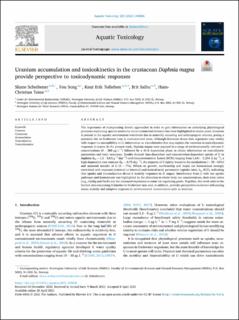| dc.description.abstract | The importance of incorporating kinetic approaches in order to gain information on underlying physiological processes explaining species sensitivity to environmental stressors has been highlighted in recent years. Uranium is present in the aquatic environment worldwide due to naturally occurring and anthropogenic sources, posing a potential risk to freshwater taxa in contaminated areas. Although literature shows that organisms vary widely with respect to susceptibility to U, information on toxicokinetics that may explain the variation in toxicodynamic responses is scarce. In the present work, Daphnia magna were exposed to a range of environmentally relevant U concentrations (0 – 200 µg L−1) followed by a 48 h depuration phase to obtain information on toxicokinetic parameters and toxic responses. Results showed time-dependent and concentration-dependent uptake of U in daphnia (ku = 1.2 – 3.8 L g−1 day−1) with bioconcentration factors (BCFs) ranging from 1,641 – 5,204 (L kg−1), a high depuration rate constant (ke = 0.75 day−1), the majority of U tightly bound to the exoskeleton (~ 50 – 60%) and maternal transfer of U (1 – 7%). Effects on growth, survivorship and major ion homeostasis strongly correlated with exposure (external or internal) and toxicokinetic parameters (uptake rates, ku, BCF), indicating that uptake and internalization drives U toxicity responses in D. magna. Interference from U with ion uptake pathways and homeostasis was highlighted by the alteration in whole-body ion concentrations, their ionic ratios (e.g., Ca:Mg and Na:K) and the increased expression in some ion regulating genes. Together, this work adds to the limited data examining U kinetics in freshwater taxa and, in addition, provides perspective on factors influencing stress, toxicity and adaptive response to environmental contaminants such as uranium. | |
